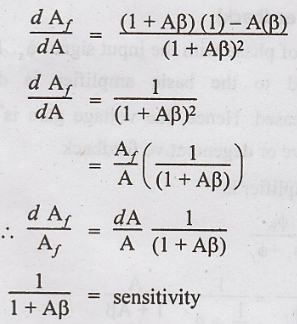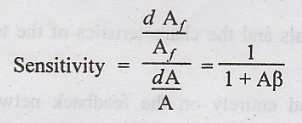Electronic Devices and Circuits: Unit IV: Feedback Amplifiers and Oscillators
Effects of Negative Feedback
The sensitivity is defined as the ratio of percentage change in voltage gain with feedback to the percentage change in voltage gain without feedback.
EFFECTS OF NEGATIVE FEEDBACK
Stabilization of Gain
The
gain of the amplifier with negative feedback is

Differentiating
the above equation with respect to A, we get,

The
sensitivity is defined as the ratio of percentage change in voltage gain with
feedback to the percentage change in voltage gain without feedback.

The
reciprocal of the term sensitivity is called desensitivity i.e., desensitivity 1
+ Aβ.
Increase of bandwidth
The
bandwidth of an amplifier is the difference between the upper cut-off
'frequency (f2) and the lower cut-off frequency f1.
The product of voltage gain and bandwidth of an amplifier without feedback and with feedback remains the same, ie Af x B Wf = A x BW
As
the voltage gain of the feedback amplifier reduces by the factor 1/(1 + Aβ),
its bandwidth would be increased by (1 + Aβ).
Due
to the negative feedback in the amplifier, the upper cut-off frequency is
increased by the factor (1 + Aβ) and the lower cutoff frequency is decreased by
the same factor (1 + Aβ).

Decrease in Output Impedance
An
amplifier with low output impedance is capable of delivering power (or voltage)
to the load without much loss. This characteristic is achieved by employing negative
series voltage feedback in an amplifier.
The
output impedance with feedback is expressed by Zof = Zo /
(1 + Aβ)
The
output impedance is reduced by a factor (1 + Aβ).
Electronic Devices and Circuits: Unit IV: Feedback Amplifiers and Oscillators : Tag: : - Effects of Negative Feedback
Related Topics
Related Subjects
Electronic Devices and Circuits
EC3353 - EDC - 3rd Semester - ECE Dept - 2021 Regulation | 3rd Semester ECE Dept 2021 Regulation
